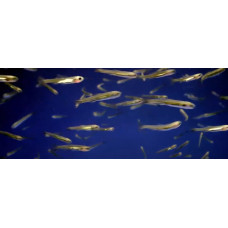Latin name
Engraulis japonicus
Other names
Engraulis japonicus
Identification
Body elongated, moderately high, height 4-5 times less than length, compressed at the sides and covered with cycloid scales, head bare. The snout is short, blunt and rounded, 2/3 of the diameter of the eyes, which is 6.9-7.1% of the length of the body. The head is small. The lower jaw has small teeth arranged in 1 row. Gill stamens thin, few in number. Gill stamens on lower part of 1st arc (17-18)+(18-25). Lateral line absent, with developed seismosensory canals on head. Mouth large, semi-low; the posterior end of the long and thin maxillary bone extends beyond the edge of the premaxilla. The scales fall off easily. The mouth opening is very wide. The large eyes are located close to the end of the snout and are covered on the outside with a transparent film of skin.
Features of fish fins
On the dorsal and anal fins, the first three rays are soft and unbranched. The fins have no barbed rays. The caudal fin is notched. The dorsal fin has 12-14 rays; the anal fin has 13-18 rays; the pectoral fins have 12-14 rays and the ventral fins have 6 rays.
Fish colouring
The back is green, the sides are bright silver, the belly is silver-white and the gill covers have a yellowish tinge.
Distribution
Occurs along the Asian coast of the Pacific Ocean, south of the Sea of Okhotsk, widely distributed in the Sea of Japan, Yellow Sea and East China Sea, and off the Pacific coast of Japan.
Habitat
Marine, pelagic-neretic, oceanodromous species. Depth range 0-400 m. Temperate climate. Usually found in surface water layers.
Size
The maximum length is 18 cm. Commercial anchovies weigh between 15 and 42 g. The average length does not exceed 14 cm. Maximum life expectancy is 4 years.
Behavior
Forms large flocks. They make regular seasonal migrations from south to north to feeding grounds. Migration routes run south along the coasts of continents and islands.
Food and feeding habits
It is a planktonophage. Juveniles feed on phytoplankton, copepod nauplii and mollusc larvae. Adults feed on zooplankton, fish eggs and larvae, including their own species.
Reproduction
Spawns in southern areas (Kyushu and Shikoku islands) in winter. The most intensive spawning occurs in autumn and spring along the Pacific coast of Honshu Island. In summer it spawns off the coast of Korea, Peter the Great Bay and off the Japanese coast of Honshu Island. Spawning takes place at temperatures of 17-19°C. Fecundity varies from 8.5 to 100,000 eggs. The eggs are pelagic, transparent, 1.4 x 0.6 mm in diameter and elliptical in shape with a segmented yolk. The larvae hatch 30 hours after fertilisation at a water temperature of 20-25°C and 48 hours at 18°C. The larvae are 3.2-3.6 mm long. In 1-2 months their length reaches 25-40 mm. The length of a one-year-old anchovy is about 11 cm, a two-year-old - 14 cm, a three-year-old - 15 cm.
Fishing
It is mainly caught in the waters of China (Bohai Strait), Japan (off the Pacific coast of Honshu Island and in the Inner Sea of Japan) and South Korea.
Relationship with a person
In Japan and Korea, anchovies have traditionally played an important role in seafood dishes. There have been reports of ciguatera poisoning.
| Classification | |
| Phylum | Chordata |
| Class | Actinopterygii |
| Squad | Clupeiformes |
| Family | Engraulidae |
| Genus | Engraulis |
| Species | E. japonicus |
| Features | |
| Conservation status | Least Concern |
| Habitat | Pelagic |
| Life span, years | 4 |
| Maximum body weight, kg | 0,042 |
| Maximum length, cm | 18 |
| Sailing speed, m/s | Planktonophage |
| Threat to people | Edible |
| Way of eating | Planktonophage |
Japanese anchovy
Tags: japanese anchovy



